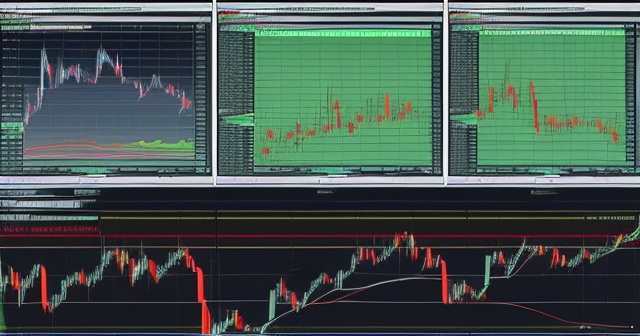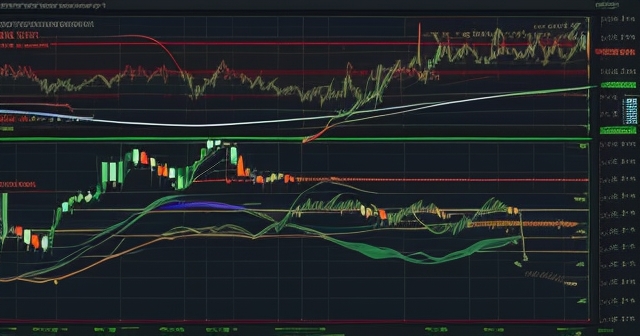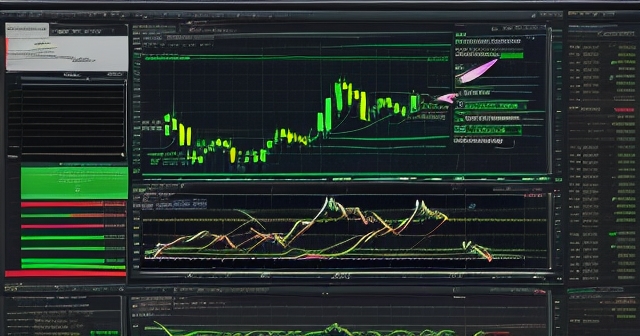
Bollinger Bands Forex: How to Master Them for Trading Success
Table of Contents
ToggleUnveiling Volatility: Mastering Bollinger Bands for Strategic Forex Trading
Welcome to a deep dive into the fascinating world of technical analysis, specifically focusing on a dynamic tool that helps traders gauge volatility and identify potential trading opportunities: Bollinger Bands.
In the often fast-paced and unpredictable Forex market, understanding price behavior is paramount. Prices don’t just move; they fluctuate, expand, and contract in relation to their average. It’s this ebb and flow, this inherent volatility, that creates trading opportunities. But how can we visually represent and effectively interpret this dynamic state? This is where Bollinger Bands come into play, offering a unique perspective on relative price levels and market sentiment.
For both novice investors taking their first steps and seasoned traders seeking to refine their approach, mastering indicators like Bollinger Bands can be transformative. They aren’t a magic bullet, but when understood and applied correctly, they become an invaluable part of your analytical toolkit. Our goal today is to help you grasp the core principles of Bollinger Bands and, more importantly, learn how to wield them effectively in the context of Forex trading, guiding you towards making more informed decisions.
We will explore the origins of this indicator, dissect its components, and reveal how its signals can be interpreted. We’ll then delve into specific strategies tailored for the Forex market and, critically, discuss how to combine Bollinger Bands with other analytical tools for stronger trade confirmations. Get ready to enhance your understanding of market dynamics and elevate your trading strategies.

Here are some key points to note about Bollinger Bands:
- Bollinger Bands consist of three lines that provide insights into price volatility.
- They help identify overbought or oversold market conditions.
- Bollinger Bands are highly adaptable, suitable for various trading strategies across different timeframes.

| Component | Description |
|---|---|
| Middle Band | The 20-period Simple Moving Average (SMA) of the asset’s price. |
| Upper Band | Middle Band + (2 * Standard Deviation of Price). |
| Lower Band | Middle Band – (2 * Standard Deviation of Price). |
The Genesis: John Bollinger and the Need for a Dynamic View
Before we break down how Bollinger Bands work, let’s briefly look at why they were created. In the early 1980s, traditional technical indicators often relied on fixed levels or simple overlays that didn’t adequately adapt to changing market conditions. A moving average is useful for identifying trend direction, but it doesn’t tell us much about whether the current price is relatively high or low compared to recent history, or how volatile the market is.
Enter John Bollinger, a renowned financial analyst and trader. He recognized the limitation of static indicators and sought a tool that could dynamically adjust to the prevailing volatility of an asset. His vision was to create a visual representation of relative price highs and lows, one that would expand when the market was active and contract when it was quiet. This led to the development of Bollinger Bands, which quickly became one of the most popular and widely used tools in technical analysis across all financial markets, including Forex, equities, commodities, and bonds.
Bollinger’s innovation wasn’t just adding bands to a moving average; it was using standard deviation, a statistical measure of dispersion, to define the distance of these bands from the average. This statistical basis is what gives the bands their dynamic quality. They are not fixed lines but rather envelopes that breathe with the market’s volatility. This dynamic adaptability is particularly valuable in the Forex market, where volatility can shift rapidly due to economic data releases, geopolitical events, or central bank policy announcements like those from the Bank of Japan or the European Central Bank.
Understanding this origin helps us appreciate the fundamental purpose of Bollinger Bands: to provide a dynamic framework for assessing price action relative to its average and the prevailing level of volatility. They give us context, helping us see if a price move is a significant deviation from the norm or just typical noise.

In the context of how Bollinger Bands relate to price movements, consider the following:
- They reflect current market conditions, adjusting as volatility changes.
- The bands widen during volatile periods, indicating potential breakout opportunities.
- Narrow bands suggest low volatility and potential imminent price movement.
Anatomy of Bollinger Bands: SMA, Standard Deviation, and the Three Bands
At its core, a Bollinger Band setup consists of three lines plotted directly onto a price chart. These lines are calculated based on the asset’s price over a specific period. Let’s break down each component:
First, there’s the Middle Band. This is typically a 20-period Simple Moving Average (SMA) of the asset’s price. The SMA smooths out price data to create a single flowing line, representing the average price over the chosen lookback period. For example, on a daily chart, a 20-day SMA is the average closing price of the last 20 trading days. This middle band serves as the base around which the other two bands are calculated and acts as a dynamic average or equilibrium point.
Second, we have the Upper Band. This band is calculated by taking the Middle Band (the SMA) and adding a certain number of standard deviations of the price over the same period. The standard deviation measures how spread out the price data is from its average. A common setting is two standard deviations. So, the Upper Band is essentially: Middle Band + (2 * Standard Deviation of Price).
Third, there’s the Lower Band. This band is calculated symmetrically by taking the Middle Band and subtracting the same number of standard deviations. Using two standard deviations again, the Lower Band is: Middle Band – (2 * Standard Deviation of Price).
Why two standard deviations? Statistically, for a normally distributed dataset, about 95% of the data points will fall within two standard deviations of the mean. While price data isn’t perfectly normally distributed, using two standard deviations means that roughly 95% of price action is expected to occur between the Upper Band and the Lower Band. This provides a powerful visual guide: prices near or outside the bands represent statistically significant moves away from the average.
The default settings of 20 periods for the SMA and 2 standard deviations are common, but you can adjust these settings based on the asset, timeframe, and your specific trading strategy. For shorter timeframes or more volatile assets, you might use fewer periods or a smaller standard deviation multiplier. However, sticking to the standard settings is often a good starting point, as many traders use them, which can sometimes lead to self-fulfilling patterns.

| Setting | Description |
|---|---|
| 20 periods (SMA) | Represents the average over 20 most recent periods. |
| 2 Standard Deviations | Defines the distance of the Upper and Lower Bands from the Middle Band. |
Interpreting Volatility: Band Width and The Squeeze
One of the most immediate insights we gain from Bollinger Bands is a clear visual representation of market volatility. How do we read this volatility? By looking at the distance between the Upper Band and the Lower Band. The wider the bands, the higher the market volatility. The narrower the bands, the lower the market volatility.
Think of it like a rubber band stretching and contracting. When the market is experiencing large price swings, the standard deviation is high, and the bands expand outwards. Conversely, when the market is quiet, with minimal price movement, the standard deviation is low, and the bands contract inwards.
This leads us to a crucial concept: “the Squeeze”. The Squeeze occurs when the Upper Band and the Lower Band converge and become very close together. This indicates a period of significantly low volatility. Why is this important? Because periods of low volatility are often followed by periods of high volatility. The market is essentially coiling up energy before a significant move.
Identifying a Squeeze can signal that a substantial price move is imminent, although it doesn’t tell us the direction of that move. Traders often look for the Squeeze as a precursor to a potential breakout. When the price finally breaks convincingly above the Upper Band or below the Lower Band after a Squeeze, it can signal the start of a new trend or a strong directional move.
Consider a quiet Forex pair like USD/JPY during low-volume hours. The Bollinger Bands might narrow significantly, forming a Squeeze. As trading volume picks up later in the day, or upon a key economic data release, volatility spikes, and the bands snap outwards as the price moves decisively in one direction. Recognizing this pattern is a key aspect of using Bollinger Bands effectively, especially when looking for potential breakouts in your Forex trading.

Here are some observations about the Squeeze and market conditions:
- A Squeeze indicates consolidation and potential upcoming volatility.
- Trading volume and external data releases often influence the breakout direction.
- Recognizing the Squeeze can be essential for timely trade setups.
Bollinger Bands as Overbought and Oversold Indicators
Beyond signaling volatility shifts, Bollinger Bands are widely used to help identify potential overbought and oversold conditions relative to the asset’s recent price history. Remember, the bands are set at a certain number of standard deviations from the average, aiming to contain a high percentage of price action.
When the price touches or moves outside the Upper Band, it suggests that the price has moved significantly above its recent average. While it doesn’t necessarily mean the price *must* reverse immediately, it signals a condition where the asset could be considered overbought in the context of its recent volatility range. This often prompts traders to look for potential selling opportunities or consider tightening stop losses on long positions.
Conversely, when the price touches or moves outside the Lower Band, it indicates that the price has moved significantly below its recent average. This can signal a condition where the asset could be considered oversold within its recent volatility range. This might lead traders to look for potential buying opportunities or consider tightening stop losses on short positions.
It’s crucial to understand that touching or exceeding a band is a *signal*, not a definitive *rule*. In strong trends, prices can ‘walk the band’, staying near or outside the Upper Band during a bullish trend or the Lower Band during a bearish trend for extended periods. This is why using Bollinger Bands in isolation for overbought/oversold signals can be misleading during trending markets. They are most effective for identifying potential reversals or temporary retracements in range-bound or less strongly trending environments, *especially* when combined with other indicators that measure momentum or trend strength.
For example, in Forex trading, if a currency pair price hits the Upper Band, you wouldn’t automatically sell. You’d look for other confirmations, perhaps a bearish divergence on the RSI or MACD, or candlestick reversal patterns. This reinforces the principle that Bollinger Bands are best used as part of a broader analytical framework, not as a standalone signal generator.
Identifying Price Patterns with Bollinger Bands
Bollinger Bands can also provide valuable context for recognizing classical price patterns, adding another layer of confirmation to potential trade setups. By observing how price interacts with the bands, you can gain insights into the strength and potential outcome of these patterns.
One common application is identifying potential reversals using formations known as ‘M’ tops and ‘W’ bottoms, which are variations of double or triple tops and bottoms. According to John Bollinger, a bearish signal can occur with an ‘M’ top pattern where the first peak forms outside the Upper Band, but the second peak forms inside the band, confirming a loss of momentum at new highs. This suggests that even though the price attempted to reach a new high, it lacked the strength to push outside the dynamic resistance offered by the band, hinting at potential weakness and a possible downward move.
Similarly, a bullish signal can occur with a ‘W’ bottom pattern. In this case, the first trough forms outside the Lower Band, while the second trough forms inside the band. This indicates that while the price initially pushed significantly lower, the subsequent attempt to retest the lows failed to break below the dynamic support of the band, suggesting a loss of selling pressure and potential upward reversal.
These ‘M’ and ‘W’ patterns, when validated by Bollinger Band interaction, provide visual cues about the underlying strength or weakness of the price move within its typical volatility range. They add weight to the idea that the market might be losing conviction at extreme levels.
Furthermore, during a strong trend, prices might “walk the band”. In an uptrend, the price stays near or along the Upper Band, often pulling back only to the Middle Band (the 20-period SMA) before resuming its move towards the upper band. In a downtrend, the price hugs the Lower Band, with bounces often limited to the Middle Band. Recognizing this “walking the band” behavior is important because it tells you the trend is strong, and simply touching the band might not be a signal to fade the trend, but rather a confirmation of its strength. Understanding these patterns helps you avoid premature entries or exits based solely on band touches.
Applying Bollinger Bands Specifically to Forex Trading
The Forex market, with its unique characteristics of continuous trading, high liquidity (for major pairs), and sensitivity to economic news, presents a particularly fertile ground for using Bollinger Bands. Why are they so useful here?
Firstly, Forex trading often involves capitalizing on relatively small price movements (pips) compared to equity trading. Therefore, tools that accurately depict dynamic price ranges and potential turning points are highly valued. Bollinger Bands, by showing the typical trading range based on recent volatility, help Forex traders identify potential entry points and exit points.
Secondly, the Forex market is heavily influenced by economic events. News releases (like interest rate decisions, inflation data, or GDP figures) can cause sudden spikes in volatility. Bollinger Bands visually capture these volatility shifts almost instantly, widening dramatically during news-driven moves. This helps traders understand if a price spike is an extreme deviation or the start of a new, more volatile regime. Conversely, periods of low volatility, often preceding major news announcements, are clearly shown by the bands’ contraction (the Squeeze), alerting traders to the potential for a large move.
Thirdly, Forex trading occurs across multiple timeframes simultaneously. Bollinger Bands are applicable on any timeframe, from minute charts used by scalpers to daily or weekly charts used by swing or position traders. A Squeeze on a 15-minute chart might signal a breakout over the next hour, while a Squeeze on a daily chart could precede a multi-day or multi-week trend.
If you’re considering starting Forex trading or exploring more CFD products, then Moneta Markets is a platform worth considering. It’s from Australia and offers over 1000 financial instruments, suitable for both beginners and professional traders.
Consider using Bollinger Bands on a currency pair like USD/JPY. If the price is hovering near the Lower Band, especially after a significant downtrend, it might indicate an oversold condition. A potential strategy could involve looking for a long entry confirmation from another indicator (like RSI showing positive divergence) as the price respects the Lower Band. Conversely, if the price reaches the Upper Band during an uptrend, it might signal a potential area to take profits or look for a short entry if other indicators confirm waning bullish momentum.
Remember, in Forex, risk management is crucial due to leverage. Using tools like Bollinger Bands to identify potential, statistically probable turning points or breakout opportunities is one part of a comprehensive trading strategy that must also include proper position sizing and stop-loss placement.
Crafting Trading Strategies Using Bollinger Bands
Having understood the components and interpretations of Bollinger Bands, let’s explore some ways we can build trading strategies around them, specifically within the Forex context. Remember, the core idea is to use the bands to define relative price levels and assess volatility.
One basic strategy is “Band Touches”. This involves looking for buy signals when the price touches or crosses below the Lower Band (suggesting oversold) and sell signals when the price touches or crosses above the Upper Band (suggesting overbought). However, as discussed, this strategy is prone to false signals in trending markets. It works better in sideways or range-bound markets, where price is more likely to revert to the mean (the Middle Band).
A more robust approach is the “Squeeze Breakout” strategy. This focuses on identifying periods of low volatility (the Squeeze) where the bands narrow significantly. Traders anticipate a subsequent increase in volatility and a directional move. The strategy involves placing pending buy orders just above the Upper Band and pending sell orders just below the Lower Band during the Squeeze. When the price breaks out and triggers one of the orders, the other order is cancelled. This capitalizes on the anticipated expansion of volatility following the contraction, aiming to catch the beginning of a new move. For this to be effective, you need to ensure sufficient data points are available to accurately identify the Squeeze on your chosen timeframe.
Another strategy utilizes the Middle Band (the 20-period SMA) as a dynamic support or resistance level. In a strong uptrend, price will often bounce off the Middle Band after a minor pullback towards it from the Upper Band. In a downtrend, price bounces off the Middle Band downwards after a retracement from the Lower Band. Trading bounces off the Middle Band in the direction of the prevailing trend can be a valid strategy, often combined with other trend-following indicators.
Some traders also use Bollinger Bands to set stop losses or take profits. For instance, if you enter a long trade as the price bounces off the Lower Band, you might set a profit target at the Middle Band or the Upper Band. Alternatively, in a trending market where price is walking the band, a stop loss could be placed below the Middle Band, signaling that the trend might be weakening if price closes below it.
Implementing these strategies requires a trading platform that offers robust charting tools and reliable execution. In choosing a trading platform, Moneta Markets‘ flexibility and technical advantages are worth mentioning. It supports MT4, MT5, Pro Trader, and other mainstream platforms, combining high-speed execution with low spread settings for a good trading experience.
Remember, no strategy is foolproof. The key is testing and refining your approach, perhaps starting with a demo account, to see how these strategies perform on the specific currency pairs and timeframes you trade, and always using them in conjunction with other indicators.
The Power of Combination: Pairing Bollinger Bands with Other Indicators
This is perhaps the single most important piece of advice regarding Bollinger Bands: **never use them in isolation**. John Bollinger himself strongly advises combining them with other, non-correlated indicators. Why? Because Bollinger Bands primarily measure volatility and relative price levels. They do not inherently measure momentum, trend strength, or market sentiment in the same way other indicators do. Combining different types of indicators provides confirmation and reduces the likelihood of false signals.
What kinds of indicators pair well with Bollinger Bands? Generally, you want to combine them with indicators from different categories:
- **Momentum Indicators:** These measure the speed and strength of price movements. Examples include the Relative Strength Index (RSI) and the Stochastic Oscillator. If price touches the Upper Band (potential overbought) while the RSI is also showing an overbought reading (above 70), it’s a stronger signal than the band touch alone. Similarly, if price hits the Lower Band (potential oversold) while the RSI is oversold (below 30), the signal is more robust. Looking for divergence between price (touching bands) and momentum indicators (making higher or lower highs/lows) is also a powerful combination strategy.
- **Trend-Following Indicators:** These help confirm the direction and strength of the trend. Examples include other Moving Averages (MAs) or the Moving Average Convergence Divergence (MACD). If price breaks out of a Squeeze above the Upper Band, and the MACD line has just crossed above the signal line and is rising, it strengthens the bullish breakout signal. If price is walking the Upper Band in an uptrend, and the MACD histogram is showing increasing bullish momentum, it confirms the strength of the trend.
- **Volume Indicators:** While less applicable directly to Forex spot trading (which lacks a central exchange volume), volume analysis is crucial in other markets like equities and can be correlated conceptually in Forex by looking at tick volume or related futures market volume. A breakout from a Squeeze accompanied by high volume is generally considered more valid than one on low volume.
The synergy comes from requiring multiple pieces of evidence to support a trade idea. For instance, a potential sell signal could be generated by price hitting the Upper Band, confirmed by RSI being overbought, and further validated by a bearish cross on the MACD. This layered approach significantly improves the reliability of trading signals compared to relying on just one indicator.
Practice combining these indicators on historical data and a demo account to see how their signals align or diverge. Understanding these relationships is key to developing sophisticated and effective trading strategies using Bollinger Bands in the Forex market.
Advanced Bollinger Band Techniques: More Than Just Basic Signals
Once you’re comfortable with the basic application and interpretation of Bollinger Bands, there are more advanced techniques that seasoned traders employ to gain further insights and refine their trading strategies.
One such technique involves using multiple sets of Bollinger Bands on the same chart. A common setup uses the standard 20-period SMA with 2 standard deviations alongside a second set, perhaps with the same 20-period SMA but a different standard deviation, such as 1 standard deviation. This creates tighter inner bands and wider outer bands.
How is this useful? The area between the 1-standard deviation band and the 2-standard deviation band can be interpreted as areas of moderate or strong trend movement. A price move that stays within the 1-standard deviation bands suggests lower volatility or weaker momentum, while a move that reaches or exceeds the 2-standard deviation bands indicates higher volatility or stronger momentum. This multi-band setup can help differentiate between minor retracements (staying within the inner bands) and more significant moves or potential turning points (reaching the outer bands).
Another advanced concept involves analyzing the shape and angle of the bands themselves. Bands that are angled upwards and widening indicate a strong bullish trend with increasing volatility. Bands angled downwards and widening signal a strong bearish trend with increasing volatility. Bands that are flat and narrow indicate a sideways market with low volatility. Recognizing these shapes can provide a quick visual assessment of the market’s state.
Furthermore, traders can study the behavior of prices “walking the band” more closely. As mentioned earlier, price often sticks to the Upper Band in strong uptrends and the Lower Band in strong downtrends. Understanding the dynamics of this “walk” – how often price touches the band, how far it pulls back to the Middle Band, and the momentum on subsequent moves – can help identify trend strength and potential fatigue.
Lastly, analyzing the *behavior* of the Squeeze breakout is crucial. Not all breakouts are equally reliable. A convincing breakout is typically accompanied by increasing volume (or tick volume in Forex) and follow-through price action in the direction of the breakout. False breakouts, often leading to whipsaws, might see price quickly snap back inside the bands. Combining the Squeeze with other indicators, as discussed previously (e.g., confirming momentum with MACD or RSI) is vital for increasing the probability of a successful breakout trade.
These advanced techniques require practice and observation. Experiment with different band settings and look at historical charts to see how price interacted with these levels during various market conditions on your preferred timeframes and currency pairs.
Risk Management and Practice: Essential for Bollinger Band Trading
We’ve covered the mechanics, interpretation, and strategy potential of Bollinger Bands. Now, let’s address arguably the most critical aspect of trading, especially in the leveraged Forex market: risk management.
No technical indicator, including Bollinger Bands, can predict the future with certainty. Markets are influenced by countless unpredictable factors. Therefore, every trade involves risk, and protecting your capital must always be your top priority. Relying solely on Bollinger Band signals without proper risk management is a recipe for disaster.
How does risk management tie into using Bollinger Bands? Firstly, the bands can help you define potential stop-loss levels. If you enter a long trade because the price bounced off the Lower Band, a logical place for a stop loss might be just below that Lower Band or below a recent swing low, depending on your strategy and the specific setup. Similarly, on a short trade from the Upper Band, a stop loss could be placed just above the Upper Band or a recent swing high. This helps limit potential losses if the trade moves against you.
Secondly, understanding volatility through the bands is crucial for position sizing. During periods of high volatility (wide bands), price can move against you more quickly and by larger amounts. This means you might need to trade smaller position sizes to keep your potential dollar loss per trade within acceptable limits, even if your stop loss is set at a technically sound level. Conversely, during periods of low volatility (the Squeeze), you might potentially use slightly larger positions, but you must be prepared for the rapid expansion of volatility that is likely to follow.
Thirdly, always determine your risk-to-reward ratio *before* entering a trade. If your potential profit target based on the bands (e.g., the Middle Band or Upper Band) is small relative to your potential loss (stop loss), the trade might not be worth taking, even if the Bollinger Band signal looks promising.
Given the complexity and risks involved in trading, especially with leverage in Forex, practice is indispensable. This is where **demo accounts** become invaluable. They allow you to apply the Bollinger Bands strategies discussed, combine them with other indicators, and practice your risk management strategy in a simulated environment using real-time market data, without risking actual capital.
If you are looking for a regulated Forex broker offering global trading capabilities, Moneta Markets has multi-jurisdictional regulatory certifications such as FSCA, ASIC, and FSA. They also provide segregated client funds, free VPS, and 24/7 customer support in Chinese, making them a preferred choice for many traders seeking a complete package.
Treat your demo account like a real one. Take trades based on your analysis using Bollinger Bands and other tools, set stop losses and profit targets, and review your performance. This hands-on experience is the best way to build confidence and competence before trading live funds. Remember, consistent profitability in trading comes from a solid analytical approach combined with disciplined risk management.
Conclusion: Synthesizing Bollinger Bands for Informed Trading
We’ve journeyed through the world of Bollinger Bands, from their statistical foundation to their practical application in Forex trading. We’ve seen how they provide a dynamic view of market volatility and relative price levels, helping us identify potential overbought and oversold conditions, recognize price patterns, and anticipate shifts in market behavior like the Squeeze.
Bollinger Bands are a powerful tool because they adapt to the market’s changing temperament, offering insights that static indicators cannot. They are applicable across all asset classes and timeframes, making them versatile for different trading strategies and styles.
However, the key takeaway, emphasized by their creator John Bollinger and echoed by experienced traders, is that they are best used in conjunction with other non-correlated technical indicators. Combining Bollinger Bands with momentum indicators like RSI or trend indicators like MACD creates a more robust analytical framework, providing confirmation signals that enhance the reliability of your trade setups.
Mastering Bollinger Bands, like any technical tool, requires dedication, study, and most importantly, practice. Start by understanding their basic principles, then explore how they behave on the specific currency pairs and timeframes you are interested in. Use a demo account to test strategies, refine your interpretations, and build the discipline necessary for effective risk management.
By integrating Bollinger Bands into your analysis, not as a standalone system but as a valuable layer of insight into volatility and relative price, you can enhance your ability to identify higher-probability trading signals and navigate the complexities of the Forex market with greater confidence. Continue learning, keep practicing, and always prioritize protecting your capital.
bollinger bands forexFAQ
Q:What are Bollinger Bands?
A:Bollinger Bands are technical analysis tools that depict volatility and relative price levels, consisting of a middle band (SMA) and two outer bands (calculated using standard deviations).
Q:How do I use Bollinger Bands in Forex trading?
A:You can use Bollinger Bands to identify overbought or oversold conditions, gauge market volatility, and develop strategies based on price interactions with the bands.
Q:Can I trade using Bollinger Bands alone?
A:It is advised to combine Bollinger Bands with other indicators for confirmation to reduce the likelihood of false signals and enhance trading strategy reliability.
You may also like
Calendar
| 一 | 二 | 三 | 四 | 五 | 六 | 日 |
|---|---|---|---|---|---|---|
| 1 | 2 | 3 | 4 | 5 | 6 | 7 |
| 8 | 9 | 10 | 11 | 12 | 13 | 14 |
| 15 | 16 | 17 | 18 | 19 | 20 | 21 |
| 22 | 23 | 24 | 25 | 26 | 27 | 28 |
| 29 | 30 | 31 | ||||
發佈留言
很抱歉,必須登入網站才能發佈留言。